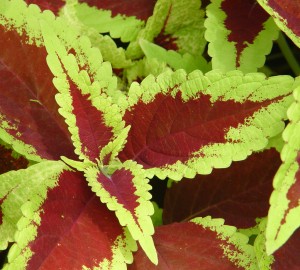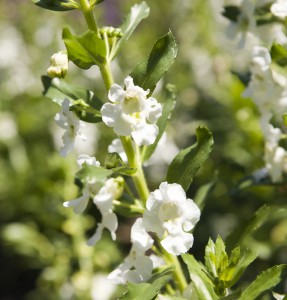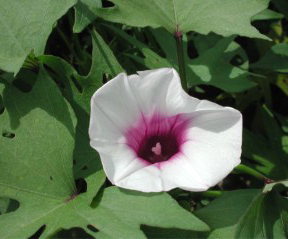Plant Profile: Mosholu Gate Containers
Posted in Around the Garden, Gardening Tips on July 3 2012, by Sonia Uyterhoeven
Sonia Uyterhoeven is the NYBG’s Gardener for Public Education.

One of the easiest ways to get to The New York Botanical Garden is via the Metro-North railroad. If you take the Harlem Line from either Grand Central or 125th Street, you can get to the Garden in 10 to 20 minutes depending on where you board. On the weekends, Metro-North offers inexpensive City Tickets which are just slightly higher in cost than subway fare. Once you get off the train, simply walk across the street and into the Garden.
Upon entering, you will see two large, square in-ground containers directly in front of the ticket booths. This year, these containers are adorned with a dramatic combination of easy-to-grow annuals that highlight the merits of mixing light and dark colors together in the garden.
The large containers include two different types of coleus (Solenostemon)–a staple of any urban container arrangement. Coleus is easy to propagate and comes in a riotous spectrum of colors and combinations. One of the varieties, ‘Alabama Sunset’, is often on gardeners’ “Top Ten” lists for successful summer annuals. It is a striking combination of brick red and golden yellow.
Unlike many coleuses that flourish in partial shade, this variety (like many of the newer cultivars) is just as happy in full sun. In partial shade the golden markings change to a yellowish chartreuse. It forms a nice 30-inch mound that requires minimal care. This coleus reminds me of molten lava.
The other coleus, ‘Red Carpet’, has more of a creeping or sprawling habit with small burgundy foliage that has a scalloped golden edge. The variegated edge gives the scalloped foliage definition and accentuates the silky burgundy interior.

The spiky accent featured in the containers is provided by summer snapdragon, Angelonia Angelface® ‘White’. This variety is part of an award-winning series that has a nice upright branch structure reaching 18 to 24 inches tall. The foliage on this summer snapdragon is fragrant. The growers describe it as a slight grape aroma, but I think it smells like raw peas. You do not have to deadhead this annual and it is heat and drought tolerant once established. It also provides the added bonus of attracting hummingbirds and butterflies.
Fan flower, Scaevola ‘Oro Blue’ spills into its neighbors and over the edges of this container. The fan flower is about 10 inches tall with a semi-trailing habit. It is wonderful for containers and hanging baskets. Another no-fuss annual, it performs well in the summer heat but shouldn’t be allowed to dry out.
The fifth and final addition to the container is something we are all familiar with due to its popularity, if not ubiquity. It is the golden-leaved sweet potato, Ipomoea batatas ‘Margarita’. The sweet potato vine only reaches 10 to 12 inches tall on average, but then it trails anywhere from three to five feet. It is a vigorous grower and it is important to remove some of the stem and cut others back so that it does not overwhelm the container. The above companions are fairly robust, and minimal pruning should be required in this arrangement to keep everything in its place.

Often people ask if the sweet potato on the ornamental sweet potato vines is edible. ‘Margarita’ is bred more for its foliage than its tubers. It does form tubers and they are edible, but they are not sweet and tasty like the sweet potato that you will find in your supermarket. They will have a more starchy taste. (Warning: never eat something unless you are absolutely sure it is edible. In the plant kingdom, one species of a genus can be edible and another poisonous, so make sure you know what you are eating.)
The annuals in this combination all cleverly tie together. The golden sweet potato vine brings out the golden highlights in the coleus. The white is a nice clean color that amplifies all the other colors in the container. White has the effect of turning a spot light on container arrangements. The blue is also a soft purple-blue that brings out the varying shades of red in the container and makes them glisten. It contrasts beautifully with the golden sweet potato vine to create a striking color complement.
There is something both calming and vivid about this container combination. For the homeowner it is a good first stop in the garden. It provides the visitor with ideas for easy-to-grow annuals that will supply the garden with colorful foliage and flowers all summer long.

